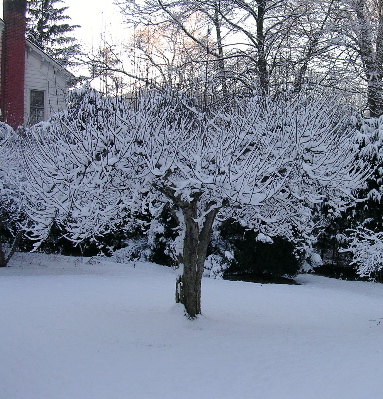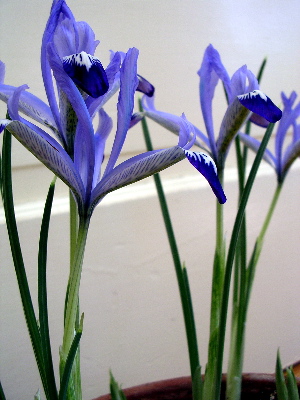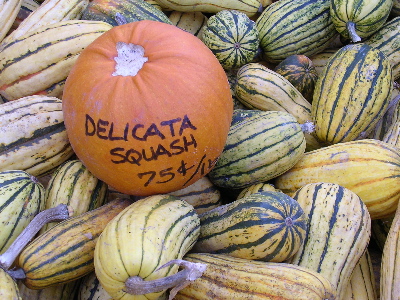Some couples disagree about when to turn on the furnace in fall, others about the proper time to ask for directions or –– if partnered, you can no doubt fill the blank. With us, it’s a long-standing difference of opinion about when to prune the rescued old fruit trees in the New York yard. Bill wants to do it in late winter, when farmers have always pruned their trees. I want it done in summer, because I know there will be more flowers, less regrowth and fewer water sprouts.
He has the weight of tradition on his side; I have nothing except being right. And as “want it done” suggests, I have ( and should have) zero say, because he’s the one who does it.

If you’re serious about summer pruning, trying to produce good fruit or a well-behaved espalier, you follow some modified form of the Lorette system, developed in the early 20th century by Louis Lorette, a professor at the Lycee Agricole in Wagnonville, France. The process is briefly described by NAFEX member Mark Lee, gone into more deeply by a publication from New Mexico State University. M. Lorette’s book itself is out of print, but there are copies – both English and French – available through Bookfinder.
The climate of the Northern US having little in common with that of the Department du Nord, modified is the operative word; you can get into trouble treating your trees as though they were in France. But assuming you’re managing mature trees, not encouraging young ones, there’s much to be said for pruning that tends to stay put.

See all those useless, non-flowering water sprouts sticking straight up? That’s a present from last year’s dormant pruning. It’s not so bad on trees that have been kept in check from infancy, but it can still be a pain in the pruner.
The Argument, Short Version:
Advantages of dormant pruning:
Leafless branch structure is clear; you can see what you’re doing
Fungus diseases are dormant too, so there’s less danger of transmission
Tree is just about to start the active growth that promotes wound-healing
You are not doing the 30,000 other agricultural things that claim your time in midsummer
Advantages of summer pruning:
Vegetative growth is restricted. Tree stays smaller.
Tree does not send up a gazillion water sprouts that must in their turn be pruned.
Fruiting spurs develop closer to main branches, and there are often more of them.
It’s ( usually) more pleasant to be working outdoors
It was 4 degrees and quiet when we woke at 6:30. Now at noon it’s up to 10 and blowing like a bandit, with merry tinkling of ice pellets against the windows and the occasional loud whoosh of something that would be granita if it had flavoring.
Inside, two harbingers of spring:

Iris reticulata is easy to force and unlike tulips, daffodils and I. versicolor (old-fashioned blue flag) it’s seldom sold by florists. This is Clairette, which is not like its picture both because it’s much more purple and because it’s much more fragrant. Catalogs seldom mention the perfume of these little charmers, but it’s definitely there and far easier to appreciate when the garden is on the tabletop.

The beans in the bag are Dr. Martin limas. !Delicious! Sweet and lima-beany and creamy, not mealy even at full huge size of over an inch wide. Didn’t used to be able to grow them in the Hudson Valley. Would cheerfully trade them for less global warming but let’s not forget the ill wind part … Seed is comparatively rare and well-worth saving; we got the original batch from Rohrer’s
For a delicious, versatile, inexpensive vegetable that has “winter” right in its name, hard-shelled squash gets surprisingly little seasonal respect. Dedicated foodies who can wax eloquent over the respective merits of yellow-eye beans and Jacob’s cattle seldom discuss the much larger differences between, say, the dry-fleshed, nutty-flavored Tetsukabuto and the creamy, well-named Sweet Dumpling.

The sign-squash is a rejected pumpkin. No stem, no sale.
Think I’m exaggerating? Have a squash tasting, using at least 3 varieties and preferably 3 species. That might be delicata (Cucurbita pepo), buttercup (C. maxima ) and butternut (C. moschata), but if you range beyond the supermarket, you can probably put together a more exotic assortment. Either way, you will be amazed, and unless there are a lot of you you will also wind up with quite a bit of extra cooked squash. Terrific! Just freeze it in meal-sized packets and you’ve got a stockpile of nearly-instant great food.
When the basic ingredient is ready to roll, it’s only minutes to warming cream of squash and orange soup, with or without a sprinkle of Aleppo pepper; baked squash under a blanket of crisp crumbs flavored with olive oil and lemon zest; or utterly simple broiled squash, spread in a shallow buttered pan and broiled until the top is dotted with flavorful, caramelized brown spots. This is also tasty with store cheese grated over it at the last minute. Also salsa. Also parsley pesto… you get the drift; if you want it even sweeter, the thing to make is pie.
To Prepare Squash for a Tasting ( or almost anything else): Heat the oven to 375 degrees. Rinse any clinging dirt from the squash and whack off the stem with the back of your heavy knife. Cut squash in half as evenly as possible and scrape out the seeds. Oil the cut surfaces with olive oil and put the squash cut side down on a sheet pan or jellyroll pan. Bake until a thin-bladed knife sides in easily, anywhere from a half hour (Sweet Dumpling) to about an hour and a half ( Marina di Chioggia), depending on the thickness of the squash meat and the variety of squash. Turn it right side up and use a sharp-edged spoon to scrape the squash meat away from the rind.








